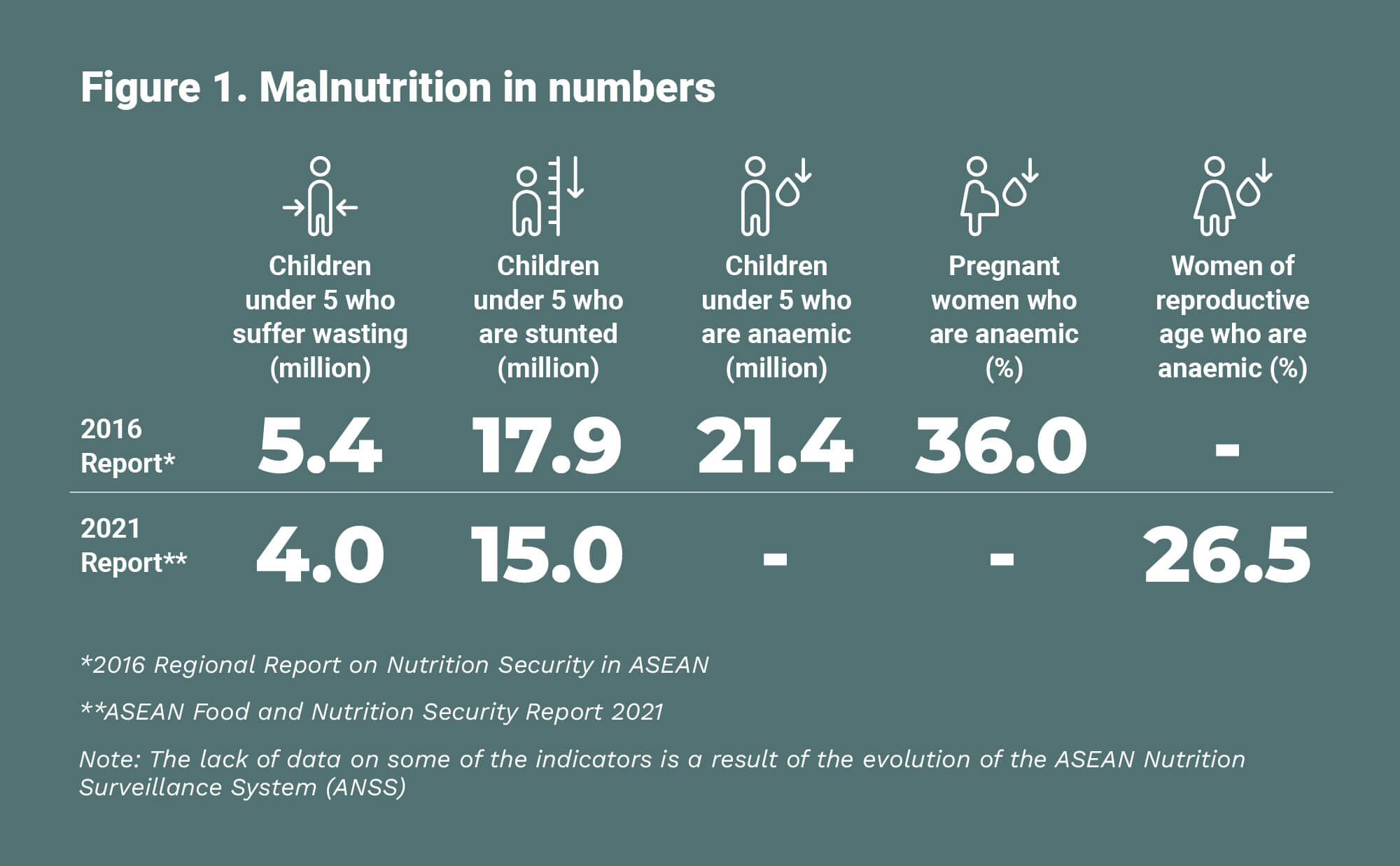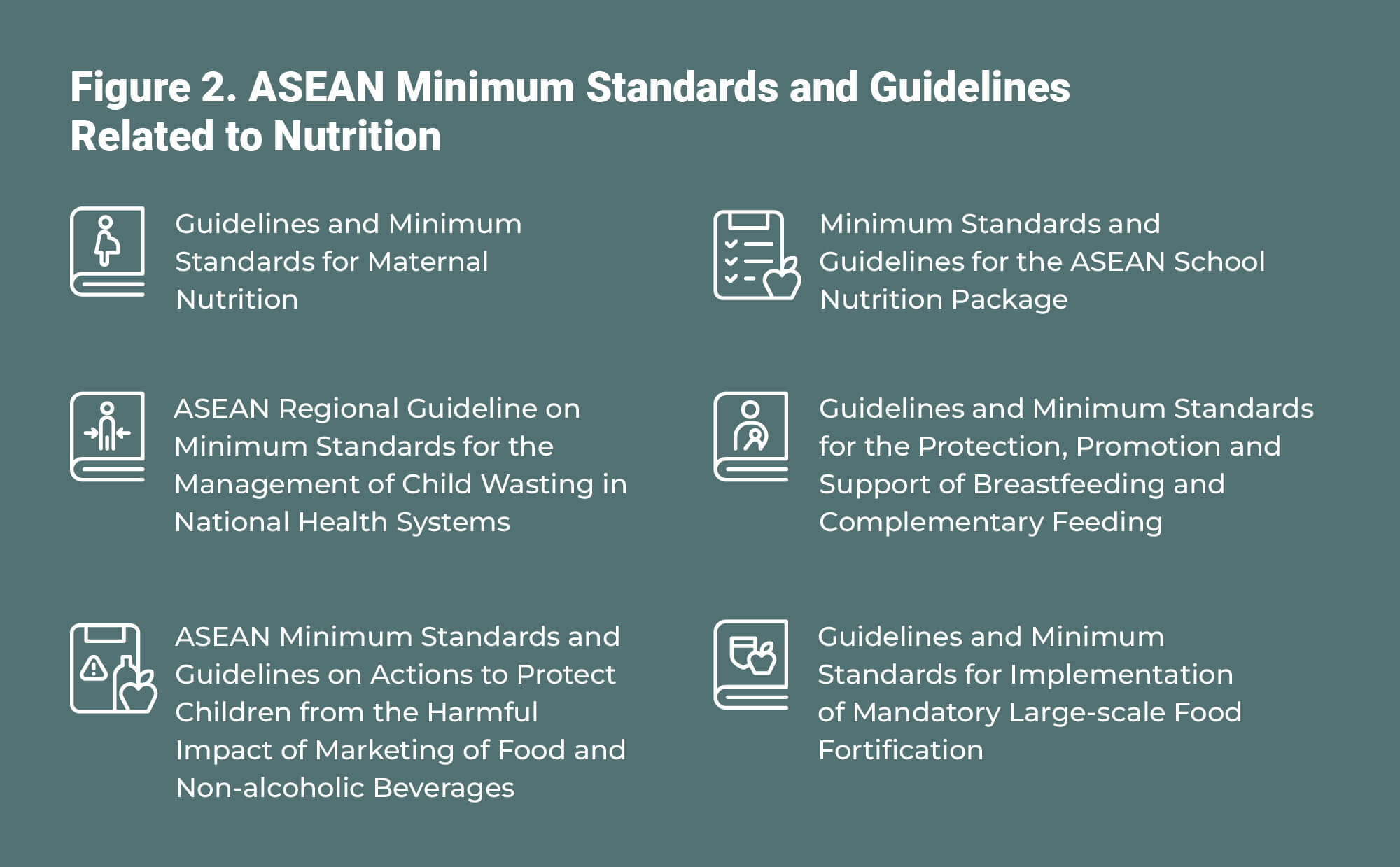






When ASEAN reached 50 years of existence in 2017, the ASEAN Leaders reaffirmed the critical importance of the health and well-being of ASEAN’s people in pursuing its growth, prosperity, and sustainability. It called for urgent, accelerated multisectoral and multistakeholder actions to end malnutrition.
Led by the Philippines, the ASEAN Leaders’ Declaration on Ending All Forms of Malnutrition in 2017 cemented the highest level of commitment to combat malnutrition. The commitment includes scaling-up evidence-based nutrition services delivery, ensuring policy coherence and support, increasing investments, strengthening human and institutional capacities, and monitoring progress of nutrition in ASEAN. The latter became the strategic thrusts of the ASEAN Strategic Framework and Action Plan on Nutrition 2018-2030 adopted by ASEAN Health Ministers.
The state of nutrition in ASEAN
ASEAN’s commitment was in response to the 2016 Regional Report on Nutrition Security in ASEAN published by ASEAN, UNICEF and WHO, which highlighted that malnutrition constitutes a severe public health, economic and ethical concern despite significant economic growth experienced by the region, as indicated by some staggering statistics (Figure 1).
In ASEAN, malnutrition not only affects the most vulnerable groups–children, pregnant and lactating women–but also the general population. The immediate causes of malnutrition include poor dietary intake, diseases, and physical inactivity. Underlying causes, meanwhile, involve insufficient access to affordable, diverse, nutrient-risk food; inappropriate maternal and child care; feeding practices and behaviours; inadequate health services and poor environment, such as the lack of safe water, sanitation, and proper hygiene. Socio-economic and political factors influence these underlying causes.
Member States face several challenges and gaps in addressing malnutrition at the regional level. Multisectoral and multistakeholder coordination remains a hurdle in a number of countries, such as in the delivery of nutrition-specific and nutrition-sensitive interventions and in increasing programme quality or engagement of other sectors to address the underlying determinants of malnutrition. The considerable burden of malnutrition also represents a significant cost to countries, resulting in substantial financial gaps in low- and middle-income countries.

Reinforcing national efforts
Guided by the ASEAN Strategic Framework and Action Plan on Nutrition 2018-2030, ASEAN implements the Declaration on Ending All Forms of Malnutrition by enacting or updating national nutrition policies, programmes, and plans of each ASEAN Member State and working with partners. At the ASEAN level, sectors responsible for health and nutrition, agriculture, education, and social welfare carry out regional advocacy, capacity building, and knowledge- and experience-sharing initiatives to reinforce national efforts.
The ASEAN Health Sector, together with other sectors and partners, produced region-specific minimum standards and guidelines to support ASEAN Member States and partners in addressing specific priorities and concerns. These include standards on maternal nutrition, school nutrition, management of child wasting, breastfeeding and complementary feeding, protection of children from harmful impact of marketing of food and non-alcoholic beverages, and food fortification (Figure 2).
Also in the agenda is the development of minimum standards and guidelines focusing on i) providing prevention and management services for childhood overweight and obesity in health facilities, ii) the healthy plate concept, iii) healthy central kitchen for childcare centres and kindergartens, iv) nutrition competency-based preservice training for frontline health workers, v) nutrition surveys and routine data systems, and vi) the integration of nutrition to social welfare, education and agriculture. The ASEAN Health Sector also plans to come up with a model for a multisectoral approach to sustain a food system for healthy diet.
The ASEAN Health Sector will further collaborate with national focal points to implement these minimum standards and guidelines and gather experiences, to help design knowledge-and experience-sharing forums and webinars, including regional trainings and capacity building workshops.
Other regional interventions and advocacies include the continued production of the ASEAN Food and Nutrition Security Report every five years, the conduct of ASEAN Non- Communicable Diseases Conferences, which prominently include nutrition, and the ASEAN Breastfeeding Forums to promote World Breastfeeding Week in August.

Nutrition and non-communicable diseases
Overweight prevalence is on the rise across age- and income-groups in ASEAN, according to the ASEAN Food and Nutrition Security Report 2021 produced in cooperation with UNICEF and the World Food Programme. Overweight results from the changing dietary pattern characterised by the consumption of foods high in energy, fats, sugars, and salt, as well as not eating enough fruits, vegetables, and other dietary fibres, such as whole grains. This pattern hinders progress in ending malnutrition and leads to the rise of non-communicable diseases.
To address this phenomenon, Indonesia led the adoption of the ASEAN Leaders’ Declaration on the Reformulation and Production of Healthier Food and Beverage Options in 2021 and is currently shepherding the finalisation of a multisectoral ASEAN Strategic Framework and Plan of Action for the Reformation and Production of Healthier Food and Beverage Options 2025-2030. This framework and plan of action build on the Framework for the Development and Implementation of Fiscal Measures on Sweet Beverages to Promote Health in ASEAN Member States led by Malaysia and adopted by ASEAN Health Ministers Meeting in 2022. It identifies priority initiatives related to incremental reduction of sodium, sugars, and fat in food and beverage products; front-of-pack labelling system; taxation; and other best-buy strategies, which will be implemented through intersectoral collaboration and regional cooperation.
Nutrition in emergencies
As a disaster-prone region concerned with the catastrophic impact of disasters, public health emergencies, and other crises on people’s nutrition, the ASEAN Health Sector prioritises nutrition-in-emergencies capacity strengthening as a component of its efforts to end malnutrition.
The Regional Training on Nutrition in Emergencies organised by Indonesia in 2018 inspired the creation of an ASEAN network and pool of experts on nutrition in emergencies. These experts will take the lead in enhancing nutrition capacities in emergencies through the delivery of technical assistance and support, development of a library of relevant references, conduct of regional advocacy, knowledge sharing, and other capacity strengthening activities. Virtual experience-sharing sessions on nutrition in emergencies have likewise been undertaken since 2022. The establishment of the network and the development of nutrition in emergencies training packages are in the pipeline.
These efforts are aligned with the policy directions of the ASEAN Leaders’ Declaration on Disaster Health Management (2017) and the ASEAN Declaration on One ASEAN One Response: Responding to Disasters as One in the Region and Outside the Region (2016).
Monitoring progress
Following the adoption of the ASEAN Strategic Framework and Action Plan on Nutrition in 2018, the Philippines led the establishment of the ASEAN Nutrition Surveillance System (ANSS) to regularly monitor trends, progress of key nutritional indicators, underlying determinants of poor nutrition, and the status of regional nutrition policies. Priority indicators include nutritional status, food availability, and access and consumption of health resources and sanitation.
Using data from ANSS, the ASEAN Food and Nutrition Security Report 2021 provided an updated snapshot of the significant progress on nutrition in ASEAN Member States and offered recommendations on priorities for the next five years (Volume 1). The Report (Volume 2) also presented data-driven food and nutrition security profiles for each of the 10 ASEAN Member States.
The ASEAN Food and Nutrition Security Report 2021 revealed encouraging progress on the reduction of stunting (15 million) and wasting (4 million) among under-five children while showing an increasing trend in overweight and obesity in children. The Report also highlighted that while progress is too slow to meet global targets, there is still time to change course to tackle persistent undernutrition and quell the increase in overweight, obesity and non-communicable diseases in ASEAN through targeted investments and commitment to scale up programmes.
ANSS is being enhanced through a web-based system with data input, updating, and validation undertaken by designated data managers from ASEAN Member States who underwent end-user training workshops in 2022. Further adjustments are being introduced to ANSS based on the results of and recommendations from the training workshops. At the same time, preparations are underway to use ANSS data in the anticipated 2026 Report.
Gearing for the “last lap”
Given the ASEAN Community Vision 2045 and guided by the upcoming ASEAN Socio-Cultural Community (ASCC) Strategic Plan, which commits to sustain efforts in ending all forms of malnutrition, ASEAN sectors are expected to update their priorities through successor work programmes for 2026-2030.
To facilitate this, a mid-term review of the ASEAN Strategic Framework and Action Plan on Nutrition 2018-2030 is planned to document progress of its implementation, including good practices and lessons in ASEAN’s multisectoral and multistakeholder efforts in ending malnutrition. The review will be complemented with findings and recommendations from the ASEAN Food and Nutrition Security Report 2026, which was developed concurrently.
The key findings and recommendations of these initiatives will be deliberated at a high-level multisectoral and multistakeholder consultation that the Philippines will organise to guide ASEAN’s “last lap” efforts to end all forms of malnutrition by 2030.








